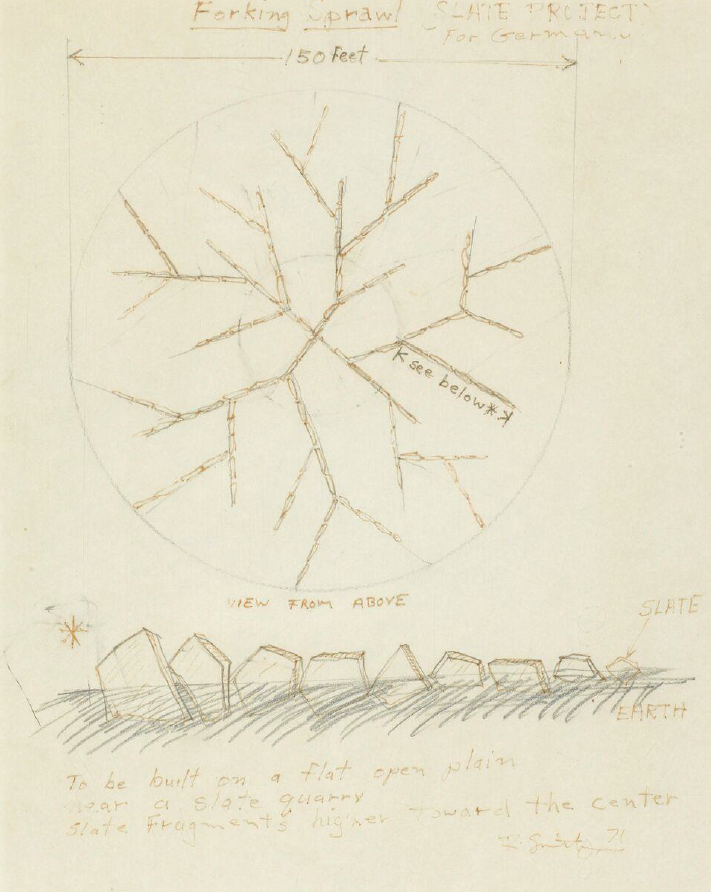
© » KADIST
Felipe Romero Beltrán
Dialect by Felipe Romero Beltrán is a photographic series that follows a group of immigrants who have recently crossed the strait (the maritime border between Morocco and Spain) to avoid border controls. The young immigrants settle in Seville while their legal situation is either resolved or refused. Reflecting on his own status as a migrant, Beltra?n’s series of photographs documenting Morrocan immigrants is a tribute to their trajectories; a trace of their existences.

© » KADIST
Erick Beltran
Drawing & Print (Drawing & Print)
In his posters, prints, and installations, Erick Beltrán employs the language and tools of graphic design, linguistics, typography, and variations in alphabetical forms across cultures; he is specifically interested in how language and meaning form structures that can be misconstrued as universal. In The Individual Is a Mirage (2010), Beltrán offers up a graphic chart mapping the myth of individual identity.
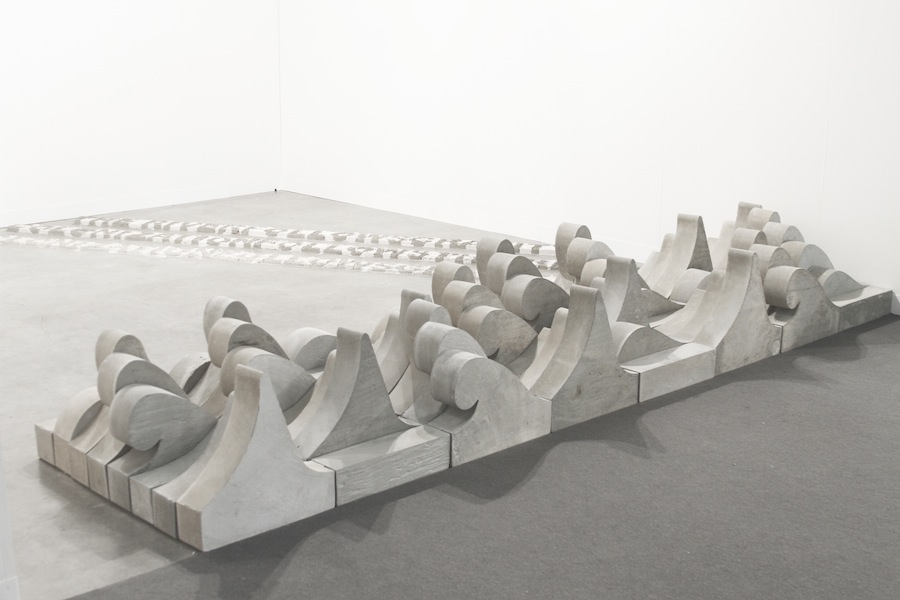
© » KADIST
Felipe Arturo
Primero estaba el mar ( First Was the Sea , 2012) is a system of equivalences between syllables and silhouettes of waveforms cast in cement. Each waveform represents a syllable of the sentence “Primero estaba el mar.” This sentence is the first verse of the Kogui poem of creation. For the Koguis, an indigenous community from the Sierra Nevada de Santa Marta on the Colombian Caribbean coast, water was the absolute presence before the creation of the universe.

© » KADIST
Felipe Dulzaides
I Am Cuba— “Soy Cuba” in Spanish; “Ya Kuba” in Russian—is a Soviet/Cuban film produced in 1964 by director Mikhail Kalatozov at Mosfilm. The movie was not well received by the Russian or Cuban public and was almost completely forgotten until its rediscovery thirty years later by American filmmakers. The movie’s acrobatic tracking shots and idiosyncratic mise-en-scène prompted Hollywood directors like Martin Scorsese to campaign to restore the movie in the early 1990s.
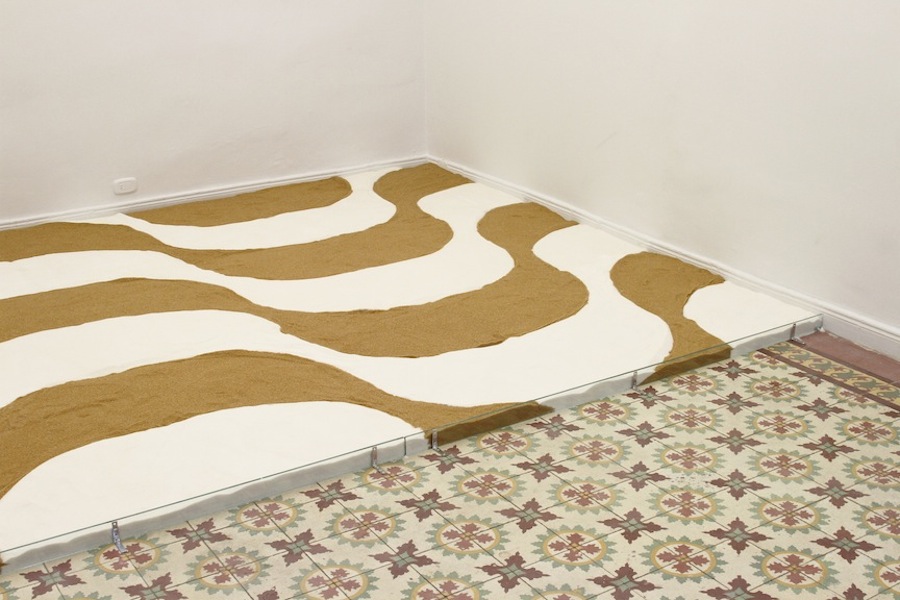
© » KADIST
Felipe Arturo
Defined as entropy, the second law of thermodynamics proposes that energy is more easily dispersed than it is concentrated. One basic illustration of entropy is to imagine white and black sand: once mixed together, it is highly unlikely that the contrasting grains of sand can be separated and restored to their original distinct color groups. Arturo’s Trópico Entrópico ( Entropic Tropics , 2012) considers the colonization of the American continent as a similarly irreversible process of cultural entropy.

© » KADIST
Bunny Rogers
In Rogers’ Columbine works, the artist explores the 1999 high school shooting that took place in Littleton, Colorado, claiming 34 victims. Rogers’ Columbine projects have focused on understanding the shooters through delving into online forums for other teenagers (many of them girls) who identify and sympathize with them. Her two-channel video work, Poetry reading in Columbine Cafeteria with Gazlene Membrane & Poetry reading in Columbine Library with Joan of Arc , focuses on two characters: Gazlene Membrane and Joan of Arc.
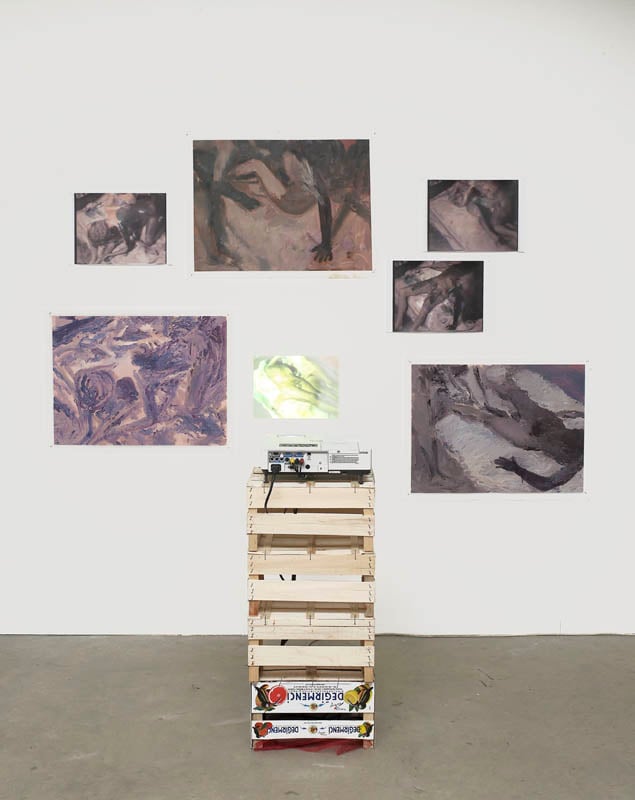
© » KADIST
Felix Gmelin
Ambiguous Gestures takes as its point of origin a film Gmelin discovered in his father’s archive. Filmed from a fixed point, it portrays his father in an intimate performance of body painting with a woman unknown to Felix Gmelin. The discovery of this footage was obviously disturbing.

© » KADIST
Felix Gmelin
In Untitled (after Paul Schultze Nuremberg’s Kunst) (2006), from a larger series of diptychs, Gmelin addresses the notion of entartete kunst ( “Degenerate Art”) . Each diptych juxtaposes a portrait of a person considered to be mentally handicapped with a painting that was branded by the Nazi regime as degenerate. Gmelin’s source for these images is Kunst und Rasse (“Art and Race”), a book by Paul Schultze Naumburg published in 1928.

© » KADIST
Robert Therrien
In No Title (Blue Chapel) Therrien has reduced the image of a chapel to a polygon. The object and its ground both glow, but the chapel-shape is crisp and simple, reminiscent of a piece of cut paper. Like many of Therrien’s early pieces, this abstraction slips into representation and the visual and spiritual power of the image is emphasized by the strong central placement of the chapel.

© » KADIST
Robert Zhao Renhui
Expedition #46 is a work from the series “The Glacier Study Group,” which consists of artists, scientists, activists, and enthusiasts of glacial and polar activity in the Artic Circle to conduct scientific investigation, data collection, and glacier sampling. Recent media attention on global warming and climate change has driven interest in increased glacial activity. The group spends long period of each year in the harsh Arctic environment to acquire in-depth knowledge of these changes while experiencing the landscape firsthand.

© » KADIST
Robert Zhao Renhui
Created during Zhao Renhui’s residency at Kadist SF in 2014, Zhao Renhui began observing and cataloguing insects inspired by the scientific impulse towards exhaustive taxonomy of Sacramento-based Dr. Martin Hauser, Senior Insect Biosystematist at the California Department of Food and Agriculture, and longtime acquaintance of the artist. In Villa Dei Fiori, September to November, Zhao Renhui tracked and collected multiple insects within the everyday urban environment, either finding the insects dead or following them around for few days.
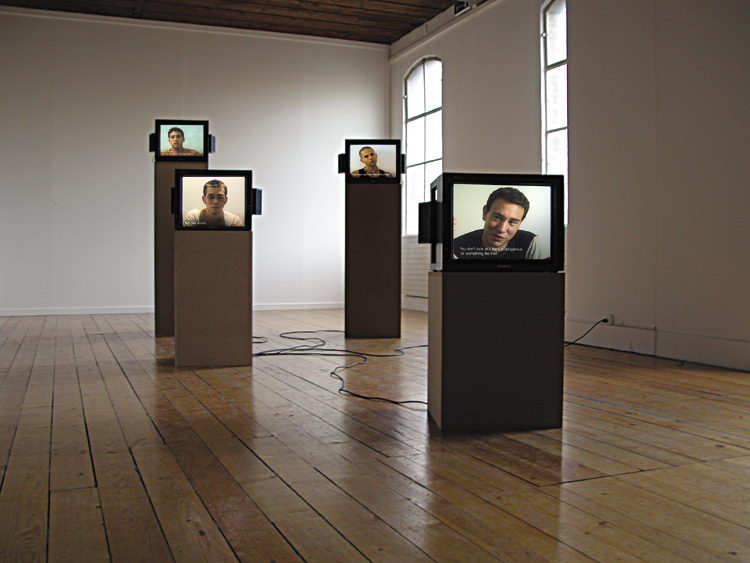
© » KADIST
Omer Fast
In this work, Omer Fast probes the feelings experienced by young people involved in an acts of war. Four monitors installed in the form a chariot of war relay the words and faces of four young Israeli soldiers. The installation shows a young generation confronted by the reality of danger, whether being attacked or facing death.

© » KADIST
Omer Fast
This work is based on a temporal loop in which the stories of several duets coexist and interfere with each other. The narrative articulates itself around four key moments or four neighboring apartments that the viewer discovers progressively: an air stewardess having an argument with her unemployed husband, and old lady telling old stories that no longer interest her caregiver, a black woman who is accused of stealing jewelry just when a newcomer, of Arab origin, moves into the apartment block. The narration itself is based on a void or non-event, however its dialogues refer to subjects such as terrorism or iimmigration.

© » KADIST
Félix González-Torres
Behind the simplicity and beauty of this untitled photograph of a brilliantly-colored flowerbed by Félix González-Torres are two remarkable stories of love, loss, and resilience. As with most of his works, the photograph is untitled followed by a parenthesis that provides some context clues. In this case, an inscription on the reverse of the photograph reads: For Laura (Alice B. Toklas + Gertrude Stein Flower Bed in Paris).

© » KADIST
Robert Zhao Renhui
Changi, Singapore, possibly 1970s is from the series “As We Walked on Water” (2010-2012), which looks into Singapore’s history around the phenomenon of land reclamation. After exhausting the country’s own soil from its tiny hills and ridges, the government had to buy sand from Malaysia and Indonesia to continue its reclamation efforts. At the early stages of a land reclamation project, the imported sand would sit idle for some time, forming an artificial desert-like landscape.

© » KADIST
Robert Zhao Renhui
Created during Zhao Renhui’s residency at Kadist SF in 2014, the photographic grid features a selection of some 6,000 members from single family of flies –hoverfly– identified over the last 25 years by Sacramento-based Dr. Martin Hauser, Senior Insect Biosystematist at the California Department of Food and Agriculture and longtime acquaintance of the artist. Worldwide specialist of hoverflies, Dr. Hauser collected the insect and meticulously sorted them out. The label below each fly indicates the country where it is from, its species, its size, etc.

© » KADIST
Robert Zhao Renhui
The photograph Proxy II (Beetles) by Robert Zhao Renhui belongs to a series, titled Christmas Island, Naturally, that focuses on the ecology of Christmas Island; a remote volcanic land formation in the Indian Ocean. Since the first settlements in the late 19th century, the ecosystems of Christmas Island have undergone devastating alterations. After nearly 150 years of human settlement, a number of invasive species have been unwittingly introduced to the island.

© » KADIST
Omer Fast
“Watching the films of Omer Fast confounds our expectations of the medium. 5,000 Feet Is the Best, 2011, is presented like a conventional big-budget Hollywood movie and has similarly high production values. Yet Fast frustrates the narrative element that Hollywood teaches us to expect: While stories unfold, repetitions and obscurities challenge the idea of a central controlling account.
Robert Zhao Renhui
Robert Zhao Renhui’s multimedia practice questions fact-based presentations of ecological conservation and reveals the manner in which documentary, journalistic, and scientific reports sensationalize nature in order to elicit viewer sympathy...
Omer Fast
- location: Yerushalayim, Yisra'el
- year born: 1972
- gender: male
- nationality: Israeli
Felix Gmelin
With a degree in painting and inspired by so-called institutional criticism, Felix Gmelin is interested in the possibilities of painting as a form of resistance and its direct relation to a form of socio-political reality...
Felipe Arturo
- year born: 1979
- gender: male
- nationality: Colombian
- home town: Bogota, Colombia
Robert Smithson
- year born: 1938
- gender: male
- nationality: American
- home town: Passaic, New Jersey
Bunny Rogers
Like many others of her generation, Bunny Rogers discovered herself through digitally mediated experiences on the Internet, finding outlets online that didn’t exist for her in the reality of her Texas upbringing...
Felipe Dulzaides
Felipe Dulzaides studied drama at the Instituto Superior de Arte of Havana and received a MFA in New Genres from the San Francisco Art Institute...
Robert Therrien
- location: Los Angeles, California
- year born: 1947
- gender: male
- nationality: American
- home town: Chicago, Illinois
Erick Beltran
- year born: 1974
- gender: male
- nationality: Mexican
- home town: Mexico City, Mexico
-
-
1980-1989
Robert Therrien
1985In No Title (Blue Chapel) Therrien has reduced the image of a chapel to a polygon...
-
1990-1999
Félix González-Torres
1992Behind the simplicity and beauty of this untitled photograph of a brilliantly-colored flowerbed by Félix González-Torres are two remarkable stories of love, loss, and resilience...
-
2000-2009
Felix Gmelin
2004Ambiguous Gestures takes as its point of origin a film Gmelin discovered in his father’s archive...
Felipe Dulzaides
2006I Am Cuba— “Soy Cuba” in Spanish; “Ya Kuba” in Russian—is a Soviet/Cuban film produced in 1964 by director Mikhail Kalatozov at Mosfilm...
Felix Gmelin
2006In Untitled (after Paul Schultze Nuremberg’s Kunst) (2006), from a larger series of diptychs, Gmelin addresses the notion of entartete kunst ( “Degenerate Art”) ...
-
2010-2019
Erick Beltran
Drawing & Print
2010(Drawing & Print) In his posters, prints, and installations, Erick Beltrán employs the language and tools of graphic design, linguistics, typography, and variations in alphabetical forms across cultures; he is specifically interested in how language and meaning form structures that can be misconstrued as universal...
Felipe Arturo
2012Primero estaba el mar ( First Was the Sea , 2012) is a system of equivalences between syllables and silhouettes of waveforms cast in cement...
Felipe Arturo
2012Defined as entropy, the second law of thermodynamics proposes that energy is more easily dispersed than it is concentrated...
Robert Zhao Renhui
2012Expedition #46 is a work from the series “The Glacier Study Group,” which consists of artists, scientists, activists, and enthusiasts of glacial and polar activity in the Artic Circle to conduct scientific investigation, data collection, and glacier sampling...
Robert Zhao Renhui
2012Changi, Singapore, possibly 1970s is from the series “As We Walked on Water” (2010-2012), which looks into Singapore’s history around the phenomenon of land reclamation...
Bunny Rogers
2014In Rogers’ Columbine works, the artist explores the 1999 high school shooting that took place in Littleton, Colorado, claiming 34 victims...
Robert Zhao Renhui
2014Created during Zhao Renhui’s residency at Kadist SF in 2014, Zhao Renhui began observing and cataloguing insects inspired by the scientific impulse towards exhaustive taxonomy of Sacramento-based Dr...
Robert Zhao Renhui
2014Created during Zhao Renhui’s residency at Kadist SF in 2014, the photographic grid features a selection of some 6,000 members from single family of flies –hoverfly– identified over the last 25 years by Sacramento-based Dr...
Robert Zhao Renhui
2016The photograph Proxy II (Beetles) by Robert Zhao Renhui belongs to a series, titled Christmas Island, Naturally, that focuses on the ecology of Christmas Island; a remote volcanic land formation in the Indian Ocean...
-
2020-2029
Felipe Romero Beltrán
2022Dialect by Felipe Romero Beltrán is a photographic series that follows a group of immigrants who have recently crossed the strait (the maritime border between Morocco and Spain) to avoid border controls...
